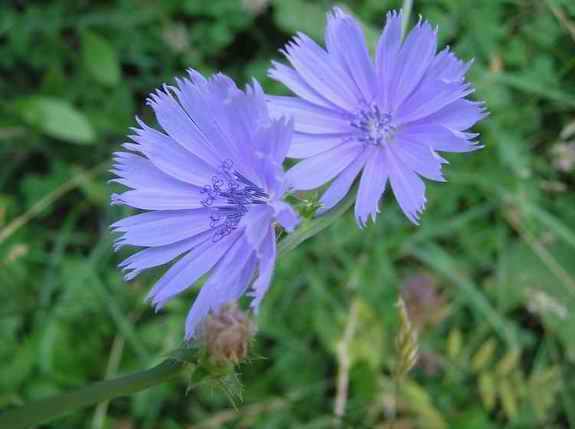|
Return to Hiker's Notebook Home Page
Common Name: Chicory, Succory, Blue Sailors, Coffeeweed, Hendibeh, Barbe de Capucin, Bunk, Ragged Sailors, Wegewarte - The Greeks knew the native European flower as kichora from which the common name chicory derives.
Scientific Name: Cichorium intybus - The generic name is from the Latin cichoreum, the name for the chicory plant and for the closely related endive, also a member of the genus. The species name is from a second Latin name for chicory, intibum, attesting to its popularity in early European culture.
The many alternative common names for Chicory reflect extend back to Egypt, where it was known as ctchorium. Another name of eastern origin is hendibeh, a postulated source of the species name intybus. The alternative name succory is thought to have an alternative etymology, deriving from the Latin succurro, to run beneath or go under; the chicory has a penetrating taproot that "goes under" to provide nutrition in tenuous environments. The German name for chicory is wegewarte which means "watcher of the road." The etiology of this curious appellation is a folk legend. A young maiden went out every morning to the road where she had last parted from her lover to await his return from a long voyage, returning every evening to her home crestfallen. She eventually succumbed to grief and died by the side of the road; the chicory grew at that spot, metaphorically opening its flowers in the morning and closing them at night to anthropomorphize her plight. This is germane as chicory does just that; it opens several flowers along the stem each morning and that last only to the afternoon, repeating the process with new flowers at different locations along the stem over several weeks.
Chicory is best known as an alternative to coffee; the substitute is made from the root, which is cleaned, dried in a kiln and roasted until brown. When ground, it is either brewed like coffee or blended with coffee to impart its distinctive flavor to the admixture. Ground chicory has about twice the soluble extractive matter of coffee, lacking the volatile oils, aromatic flavor, caffeine and tannic acid that contribute to the attraction of the latter as a popular beverage. Chicory imparts a bitter taste and a dark color to coffee, acting as a counter-stimulant to the excitation induced by the caffeine.
The use of chicory likely paralleled the importing of coffee to southern Europe from the Arabian countries; European consumption started in about the sixteenth century (the word coffee is either from the Arabic qahwe or from Kaffa, the region of Ethiopia where Arabica coffee was first domesticated). One tradition establishes the first use of chicory in Italy in 1769. Another claim is that it was in wide use in northern Europe when Napoleon's returning armies brought it to France in the early nineteenth century. Chicory made its way to North America with colonization and found widespread use in the south after the Civil War when hard times prevailed. To this day it is a mainstay of the coffeehouses of New Orleans, where chicory-flavored coffee is still popular...
Chicory is closely related to the endive (Cichorium endivia); both are employed extensively in Europe as salad greens and as vegetables, a practice that is also of some historical significance. Similar but reportedly superior to dandelion greens, chicory imparts a slight bitter taste that enhances a salad mix. Young, tender roots are boiled and eaten like carrots in France and Belgium. Witloof chicory, which is also known as Belgian endive, is grown by forcing roots to grow in the dark to produce blanched, tight heads. The French name is Barbe de Capucin, which basically means Capuchin (monk's) beard. Chicory and endive are rich in calcium, phosphorous, and Vitamin C, with only .3 grams of fat and 23 calories in a 100 gram serving.
One of chicory's main attributes as a food source is a high content of inulin, an oligosaccharide that is a form of soluble fiber. It is not affected by the digestive enzymes of the stomach, and therefore passes to the colon where it is metabolized by bacteria, stimulating their growth. The historical use of chicory root as a laxative and diuretic is likely the due to its high inulin content; chicory is reportedly approved for use as a treatment for dyspepsia (indigestion) in Germany. Some testing has been done that indicates that chicory root has antibacterial and anti-inflammatory properties. It has historically been used in folk remedies to treat jaundice and other liver disorders.
Chicory has also been widely as fodder for livestock in many countries for centuries, a practice that is gaining some adherents in this country. It grows rapidly so that two to three crops can be harvested in a single season. It has a higher mineral content and better nutritive content than alfalfa. Its deep taproot makes it very tolerant to drought and allows for its cultivation in relatively poor soil conditions. Chicory roots are grown commercially for use in pet foods. |
